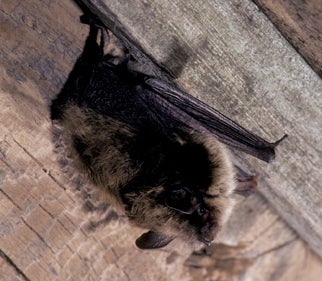Bats are the only mammals that truly fly. Their forelimbs have evolved to become wings. Bat bodies are generally well furred, but wing membranes are often naked and transparent. Unlike birds, which flap their wings up and down, bats "swim" through the air. Some species fly with the agility of swifts and occassionally hunt with such birds at dusk. Wing beats may be as rapid as 20 persecond. With wings folded, bats can walk or climb, and some can swing from branch to branch. At rest, they hang head downward, sometimes by one hindfoot, using the other to groom their fur and clean their teeth.
Despite the myth, bats are not blind. All bats can see and use sight to navigate across long distances. Bats can also see during the day. While flying, the bat emits through its nose or slightly opened mouth a continuous series of supersonic sounds (about 30 to 60 squeaks per second) that bounce off objects and are picked up by the bat's complex ears. From the way the sounds are interpreted, the bat determines size, location, density, and movement of the object it approaches. This allows it to identify and catch its insect prey.
Bats are nocturnal animals that leave their daytime roosts about dusk and usually fly to a stream, pond, or lake where they dip their lower jaws into the water to drink. They then catch insects in their mouths, or scoop them into their wings. Bats may feed as they fly, turning a somersault as they extract food from the wing membrane, or, it their meal is too large, alight to dine. Bats eat hundreds of thousands of insects annually. The myth that bats fly into people's hair is based on the fact that they often fly very close to animals, including humans, seeking the insects that sometimes swarm about their heads.




















